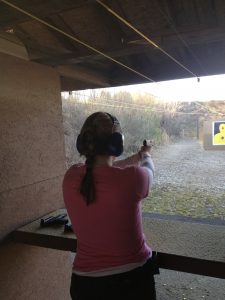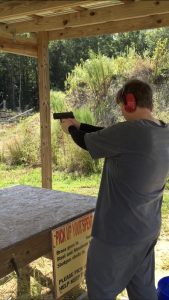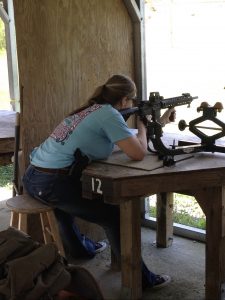We’ve all been there, especially as of late. You’ve been working for what seems like forever and the only time with a weapon is when you dry fire at home after work, or using the MantisX for training, but today is the day. You finally have some free time or a day off and want to go to the range…so what do you bring? When my wife and I are planning on going to the gun range, we like to have a game plan. When I say we have a game plan, we talk and we figure out what we want to work on. For example, “today I want to practice drawing the pistol from the holster, shooting two to the chest and one to the head and remembering to follow through.” Or today we want to practice our speed shooting on the steel targets or drawing from a seated position. Setting a game plan together is one of the most important things to start off with while you are getting ready. But what items do you bring to the range?
- Gun(s)- Pistol or Rifle
- Ammo, Ammo Can, and Mag-loader (Depends on the amount of ammo and calibers you want to shoot)
- Extra Magazines (I have at least 3 magazines for each pistol/rifle)
- Correct Hearing Protection (Ear Plugs or Earmuffs)
- Eye Protection (Clear or Sunshade)
- Holster(s)
- Carry Case(s)- Pistol or Rifle.
Those are the main items that most people carry to the range. Here are some other items to think about:
- Multi-function Tool (Leatherman, Gerber, etc)
- Allen Wrenches/Torx Bits
- Spare Parts
- Cleaning supplies:
- Bore Snake
- CLP
- Gun Scrubber
- Cleaning Kit (Rifle or Pistol)
- Microfiber Towels
- Binoculars
- Gloves
- Targets
- Staple Gun
- Water
- Hand-Sanitzer/Hand Soap
- Proper Clothing (If shooting outdoors)
- IFAK
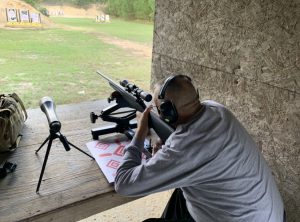 I mention the above items because these items can be overlooked. You never know when you are shooting an AR and need to make adjustments or even have parts break, so having a multi-tool, Allen Wrenches and even Torx Bits make changing out those parts or making adjustments easier. I make it a habit to also carry spare parts for my AR15 as well. Some of those parts include: firing pin, firing pin retaining pin, cam pin, extractor, extractor pin, extractor spring, gas rings, cotter pin, etc. These items can come in handy if you are competing at a 3 Gun event as well.
I mention the above items because these items can be overlooked. You never know when you are shooting an AR and need to make adjustments or even have parts break, so having a multi-tool, Allen Wrenches and even Torx Bits make changing out those parts or making adjustments easier. I make it a habit to also carry spare parts for my AR15 as well. Some of those parts include: firing pin, firing pin retaining pin, cam pin, extractor, extractor pin, extractor spring, gas rings, cotter pin, etc. These items can come in handy if you are competing at a 3 Gun event as well.
If you are shooting suppressed, then you know that suppressors get mighty hot and very fast! I like to carry a pair of gloves with me just in the event that I have to take it off quickly, and I do not want to burn my hands. Don’t get me wrong, having gloves in general and not just for suppressors can keep your hands safe. Think about when you are shooting outside on a hot summer day; in North Carolina, it can get pretty hot and humid even at 0700. These black, shiny pistols and rifles can get pretty hot just sitting out in the direct sun, so keeping your hands covered can keep you shooting comfortably all day. Or think about the winter time, having gloves on can make shooting a little bit better because they keep your hands somewhat warm.
Staying hydrated is very important in life. Some ranges, indoor or outdoor, do not have water readily available, so it is up to the shooter to carry their own. Keeping a bottle or two of water with you, or even a hydration bladder in a backpack, can keep you from overheating. Another use for water is that you can utilize one bottle of water to wash your hands if need be after shooting. Also, please practice how you plan on carrying. For example, for the ladies out there, if you are wanting to carry your pistol in your purse, please practice drawing from your purse so it’ll become second nature and develop that muscle memory. Or if the same lady is wanting to carry using some other form of concealment like with a Dene Adams Concealment Corset, please wear that and train with it. If someone is planning on carrying using an OWB holster or carrying using an appendix or IWB holster, then please practice drawing and shooting with those holsters.
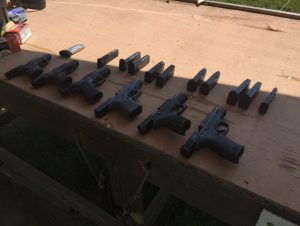 With my profession being a Paramedic, I carry some sort of IFAK – Individual First Aid Kit. If you were to be shot at the range, you are going to need much more than a band-aid – so I keep tourniquets, Israeli Bandages, and other odds and ends in my IFAK. I will be doing an IFAK review here soon with the items I carry and where you can purchase these items. It is also good practice to check with your local gun ranges and see if they have some sort of plan of action in the event someone has an accident and see where the medical kit is located at.
With my profession being a Paramedic, I carry some sort of IFAK – Individual First Aid Kit. If you were to be shot at the range, you are going to need much more than a band-aid – so I keep tourniquets, Israeli Bandages, and other odds and ends in my IFAK. I will be doing an IFAK review here soon with the items I carry and where you can purchase these items. It is also good practice to check with your local gun ranges and see if they have some sort of plan of action in the event someone has an accident and see where the medical kit is located at.
If it just so happens that you and your significant other are new to the gun market, don’t be afraid to talk to other people at the range or even the range safety officer while there. Sometimes you may find off-duty military personnel, active or retired LEO, avid USPSA/IDPA shooters, and just other gun enthusiasts that could potentially help you get your technique down and help you if any problems should arise. So, don’t be afraid to ask questions. Just remember: practice good range etiquette while following all range rules, accomplish your set goals, and don’t forget to clean your guns after you have shot them! A clean gun is a happy gun!
As always, ya’ll be good and be safe!


